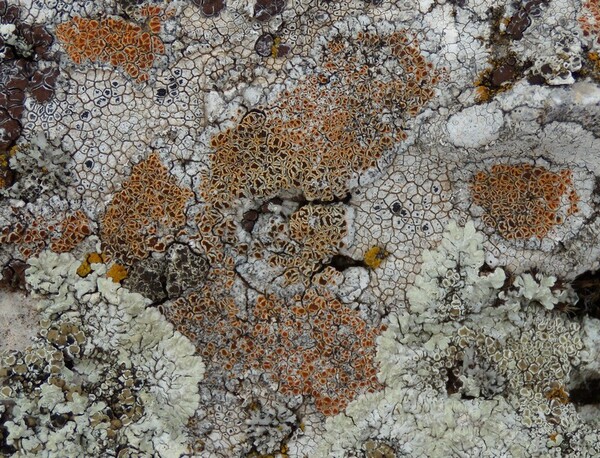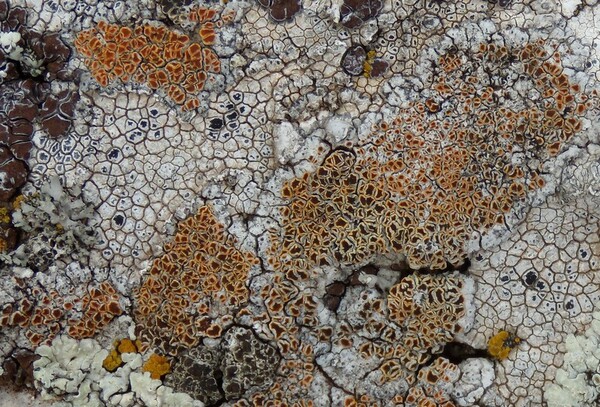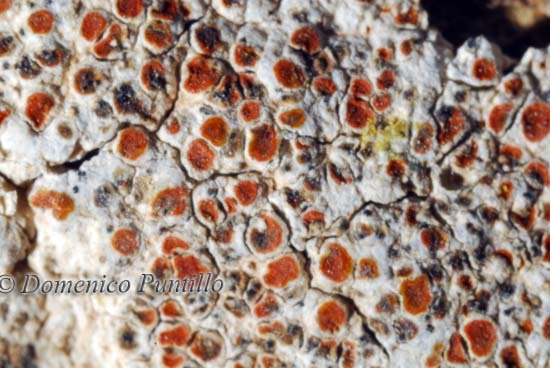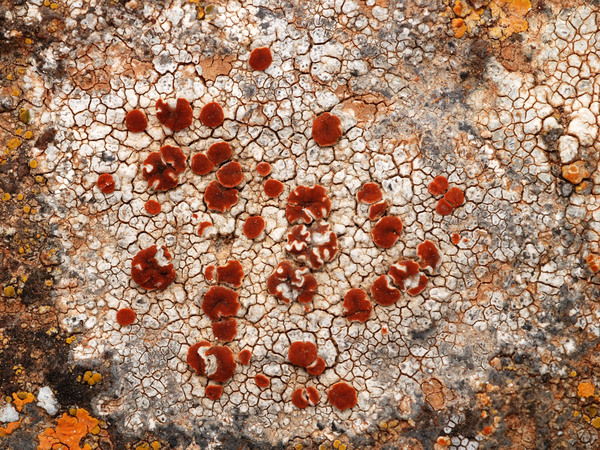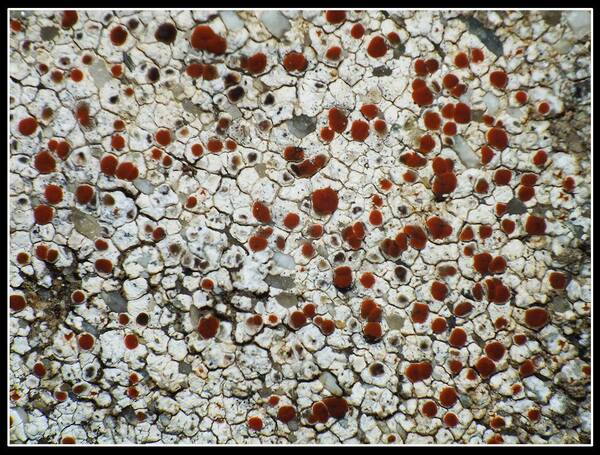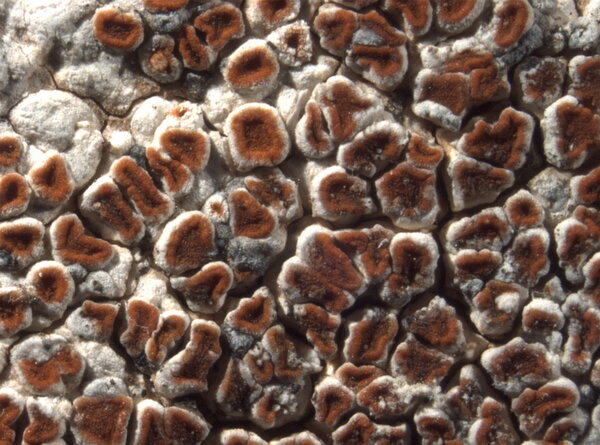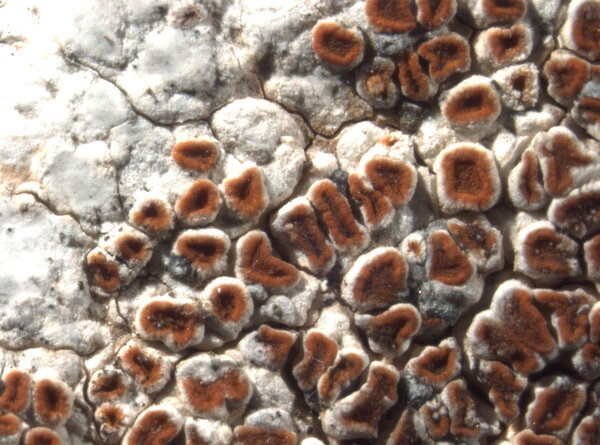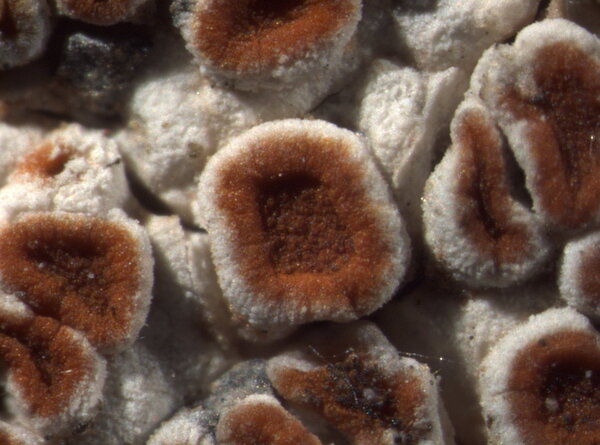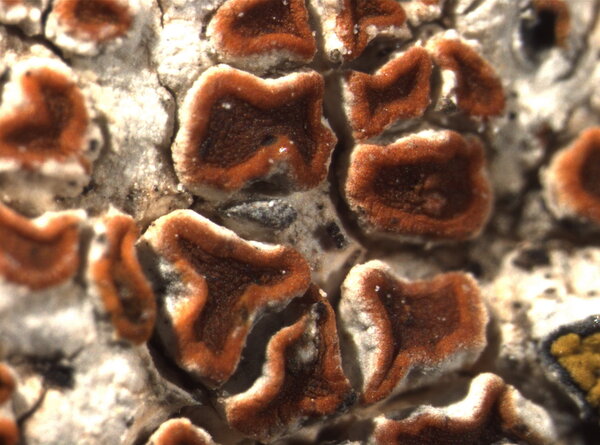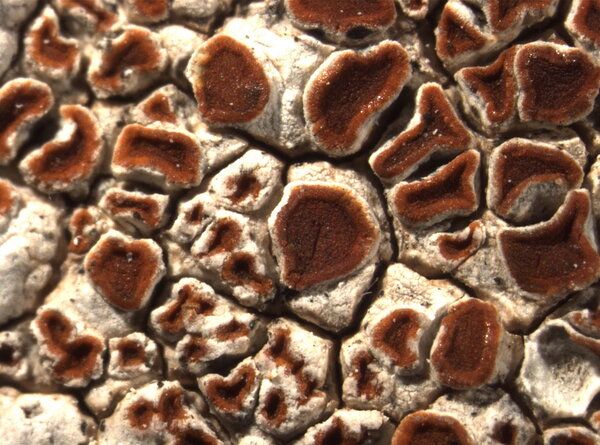Kuettlingeria erythrocarpa (Pers.) I.V. Frolov, Vondrák & Arup
in Frolov & al., J. Syst. Evol. 59, 3: 468, 2020. Basionym: Patellaria erythrocarpa Pers. - Ann. Wetter. Gesellsch. ges. Naturk., 2: 12, 1801.
Synonyms: Blastenia arenaria sensu A. Massal.; Blastenia ferruginea var. metabasis A. Massal.; Blastenia lallavei (Clemente ex Ach.) A. Massal.; Callopisma arenarium auct.; Caloplaca arenaria auct. p.p. non (Pers.) Müll. Arg.; Caloplaca erythrocarpa (Pers.) Zwackh; Caloplaca erythrocarpa f. diffractoareolata B. de Lesd.; Caloplaca lallavei (Clemente ex Ach.) Flagey; Kuettlingeria lallavei (Clemente ex Ach.) Trevis.; Placodium lallavei (Clemente ex Ach.) Anzi
Distribution: N - VG, Frl, Ven (Lazzarin 2000b, Nascimbene 2008c), TAA (Nascimbene & al. 2022), Lomb (Valcuvia & al. 2003), Piem, Emil (Valcuvia & Grieco 1995, Nimis & al. 1996, Bouvet 2008, Fariselli & al. 2020, Brackel 2025), Lig (Valcuvia & al. 2000, Giordani & al. 2016). C - Tosc (Brackel 2025), Marc (Nimis & Tretiach 1999), Umb (Nimis & Tretiach 1999, Ravera & al. 2006, Panfili 2007, Genovesi 2011), Laz (Bartoli & al. 1998), Abr (Nimis & Tretiach 1999, Caporale & al. 2016, Gheza & al. 2021), Mol (Garofalo & al. 1999, Nimis & Tretiach 1999, Caporale & al. 2008, Ravera & al. 2009, Genovesi & Ravera 2014, Brackel 2020), Sar. S - Camp (Garofalo & al. 1999, 2010, Aprile & al. 2003, 2003b, Nimis & Tretiach 2004), Pugl (Garofalo & al. 1999, Nimis & Tretiach 1999, Søchting 2001), Bas (Nimis & Tretiach 1999, Potenza 2006), Cal (Puntillo 1996), Si (Nimis & al. 1994, 1995, 1996b, Ottonello & Salone 1994, Ottonello & al. 1994, Monte & Ferrari 1996, Ottonello 1996, Schicchi & al. 1997, Grillo 1998, Poli & al. 1998, Caniglia & Grillo 2001, Grillo & al. 2001, 2002, Grillo & Caniglia 2004, Brackel 2008b, 2008c, Gianguzzi & al. 2009, Cataldo & Cannavò 2014, Campisi & al. 2020).
Description: Thallus crustose, episubstratic, chalky white, up to 0.7 mm thick, of flattened, angular areoles, the marginal ones sometimes elongate, giving the thallus a subplacodioid appearance, forming well-delimited, orbicular up to c. 5 cm wide patches, sometimes surrounded by a thin, dark prothallus. Cortex up to 60 μm thick, with abundant small crystals; medulla white. Apothecia frequent, lecanorine/zeorine, developing in the centre of areoles and in the central part of thallus, 0.4-1.5(-2) mm across, immersed to subsessile, with a flat, dark red to rust-red disc, a rust-red to orange (paler than disc) proper margin, and a finally often excluded, white thalline margin of variable thickness. Proper exciple orange in outer part, colourless within, the pigmented parts K+ purple-red, C+ purple; epithecium orange, K+ purple-red, C+ purple; hymenium colourless, 65-100 μm high; paraphyses simple or sparingly branched in upper part, not distinctly capitate; hypothecium colourless. Asci 8-spored, cylindrical-clavate, functionally unitunicate, apically thickened with a broad internal beak, the inner part of apex and external cap I+ blue, Teloschistes-type. Ascospores 2-celled, polarilocular, hyaline, ellipsoid, 12-16(-18) x 6-9(-10) μm, the equatorial thickening (“septum”) (3-)5-8 μm, up to 1/4 of spore length. Pycnidia common, immersed, appearing as dark dots. Conidia narrowly ellipsoid to bacilliform. Photobiont chlorococcoid. Spot tests: thallus K-, C, KC-, P-; apothecia K+ purple-red, C+ purple (both disc and proper margin). Chemistry: thallus without lichen substances or with low amounts of the Sedifolia-grey pigment; apothecia with chlorinated anthraquinones in both margin and disc: 7-chloroemodin (major), fragilin and emodin (minor), sometimes traces of parietin.Note: a mainly Mediterranean species also occurring in warm habitats of the submediterranean belt found on limestone, dolomite, calciferous sandstone, much more rarely mortar and brick, on horizontal to weakly inclined faces wetted by rain, with optimum in natural habitats at low elevations.
Growth form: Crustose
Substrata: rocks
Photobiont: green algae other than Trentepohlia
Reproductive strategy: mainly sexual
paras Circinaria calcarea when young
Commonnes-rarity: (info)
Alpine belt: absent
Subalpine belt: absent
Oromediterranean belt: absent
Montane belt: rather rare
Submediterranean belt: very common
Padanian area: rare
Humid submediterranean belt: extremely common
Humid mediterranean belt: common
Dry mediterranean belt: rather common
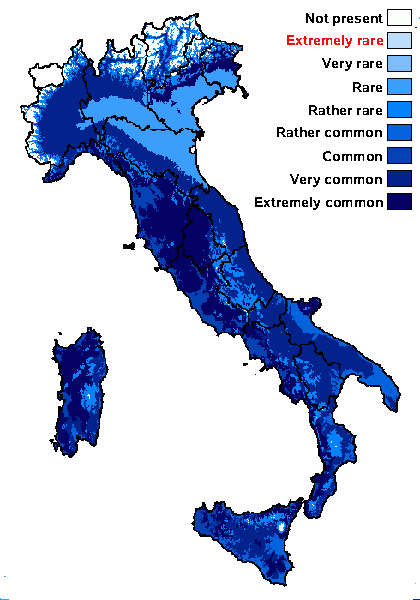
Predictive model
Herbarium samples
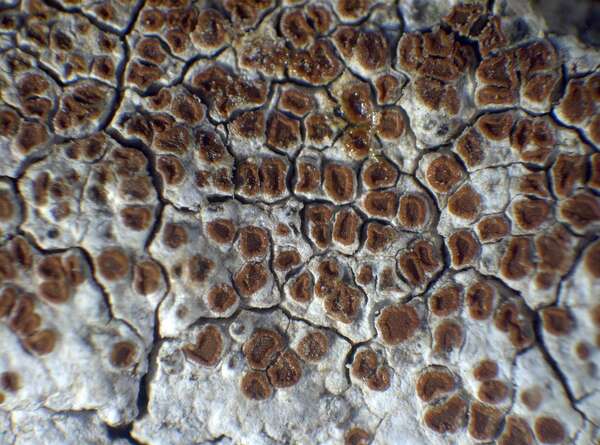

P.L. Nimis; Owner: Department of Life Sciences, University of Trieste
Herbarium: TSB (7207)
2001/11/13
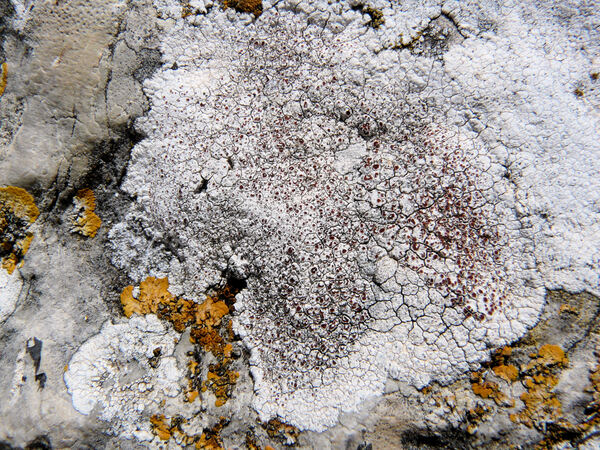

A. Moro; Owner: Department of Life Sciences, University of Trieste
Sicilia, TP, Erice, dintorni della città
2008.04.05
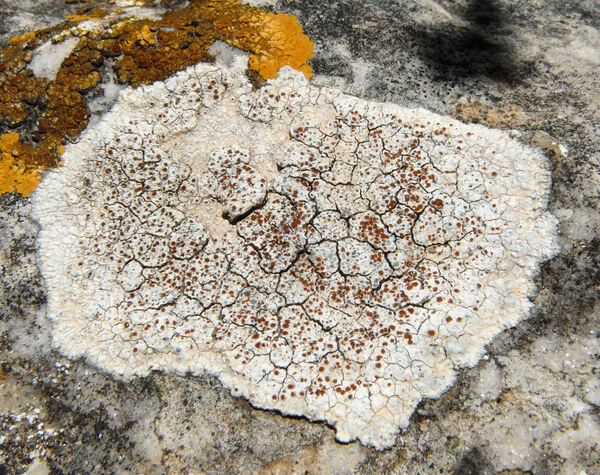

A. Moro; Owner: Department of Life Sciences, University of Trieste
Sicilia, TP, Segesta, presso i templi
2008.04.05
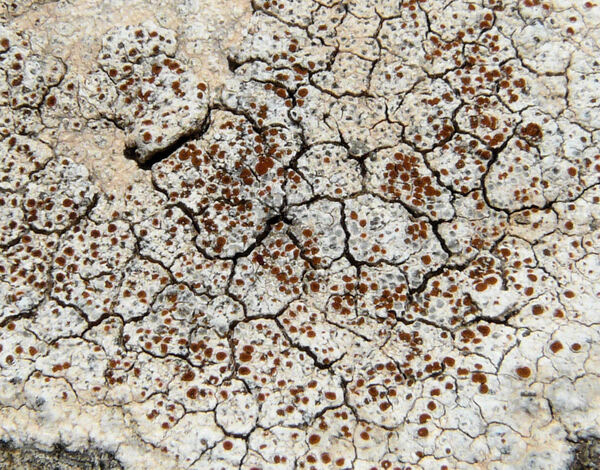

A. Moro; Owner: Department of Life Sciences, University of Trieste
Sicilia, TP, Segesta, presso i templi
2008.04.05
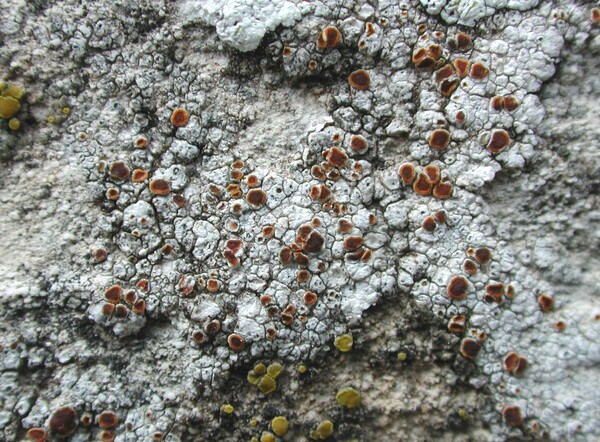

Juri Nascimbene – CC BY-SA 4.0; Owner: Department of ùLife Sciences, University of Trieste
Vette Feltrine, Veneto, Italy
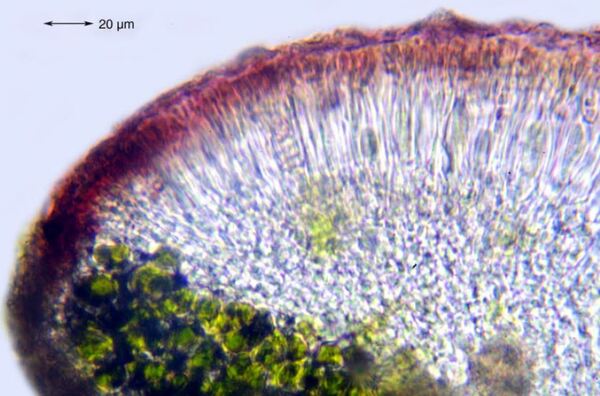

Felix Schumm – CC BY-SA 4.0
[12291], Griechenland, N-Samos, bei Manolates südlich von Agios Konstandinos, 37°47.185'N, 26°49.533'E, 341 m; halbschattige bis besonnte Terrassenmauern. Leg Schumm 02.05.2006, det. Schumm 2006.
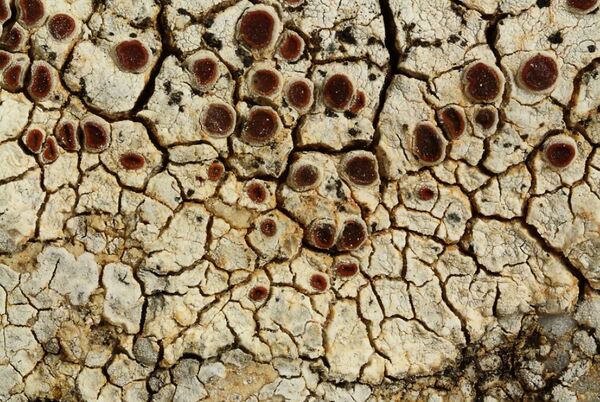

Felix Schumm – CC BY-SA 4.0
[13404], Griechenland, S-Kreta, Gebirgszug zwischen Pombia und Pigedakia, westl. des Gipfels Vigla, 34°59.880' N, 24°52.150' E, 420 m. Leg. F. Schumm & R. Düll, 16.10.2007, det. A. Aptroot 2016.
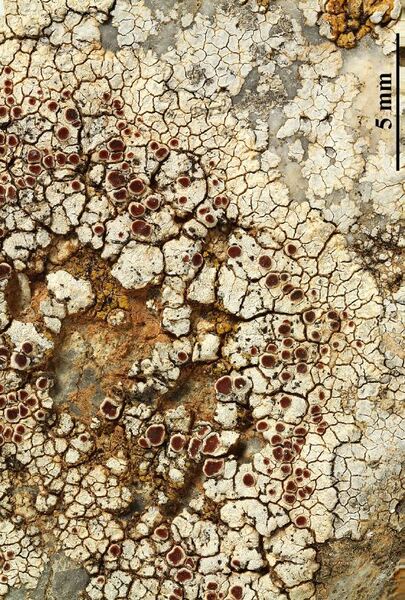

Felix Schumm – CC BY-SA 4.0
[13404], Griechenland, S-Kreta, Gebirgszug zwischen Pombia und Pigedakia, westl. des Gipfels Vigla, 34°59.880' N, 24°52.150' E, 420 m. Leg. F. Schumm & R. Düll, 16.10.2007, det. A. Aptroot 2016.
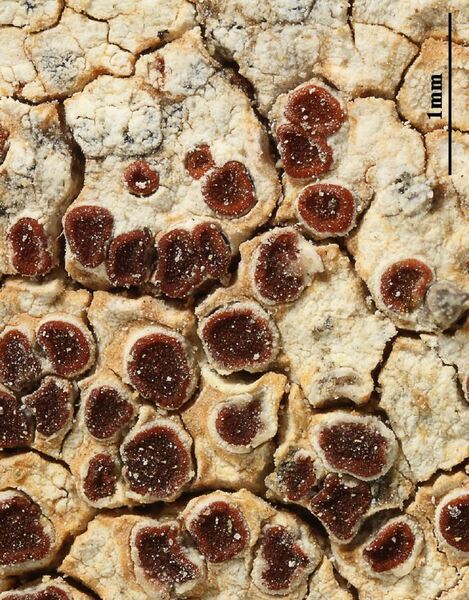

Felix Schumm – CC BY-SA 4.0
[13572], Griechenland, S-Kreta, Asteroussia Berge, Blockhalde nordöstlich von Ethia in Richtung Keraies, 34°59.526' N, 25°12.693' E, 830 m. Leg. F. Schumm & R. Düll, 25.10.2007, det. A. Aptroot 2016.
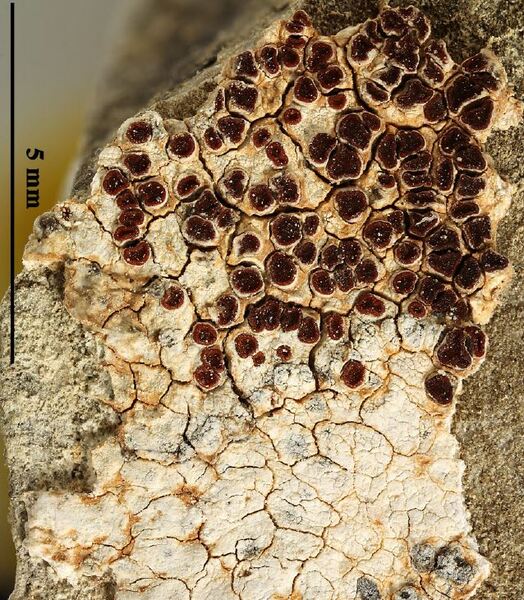

Felix Schumm – CC BY-SA 4.0
[13572], Griechenland, S-Kreta, Asteroussia Berge, Blockhalde nordöstlich von Ethia in Richtung Keraies, 34°59.526' N, 25°12.693' E, 830 m. Leg. F. Schumm & R. Düll, 25.10.2007, det. A. Aptroot 2016.
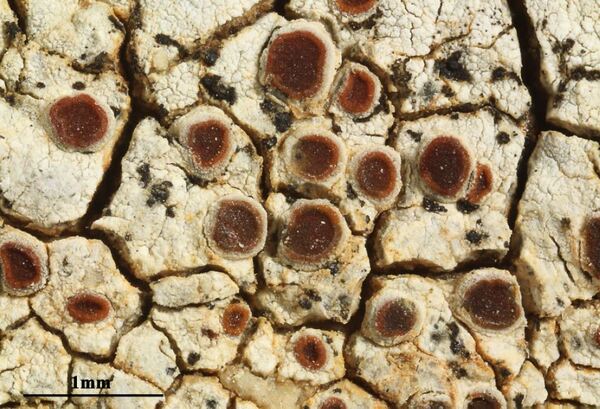

Felix Schumm – CC BY-SA 4.0
[13404], Griechenland, S-Kreta, Gebirgszug zwischen Pombia und Pigedakia, westl. des Gipfels Vigla, 34°59.880' N, 24°52.150' E, 420 m. Leg. F. Schumm & R. Düll, 16.10.2007, det. A. Aptroot 2016.
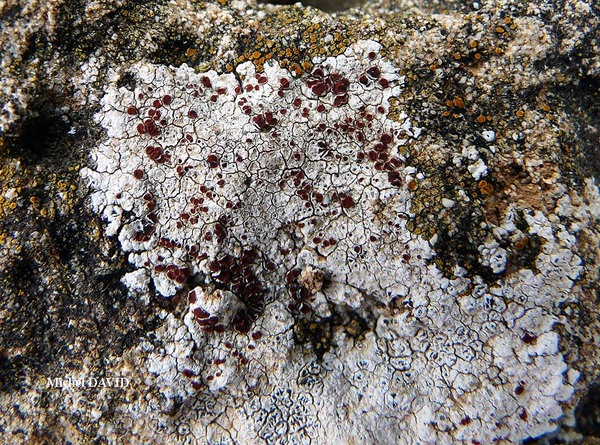
Michel David - Source: http://www.lichensmaritimes.org/index.php?task=fiche&lichen=911&lang=en
Greece, parasitant Aspicilia calcarea Crète Héraklion

Michel David - Source: http://www.lichensmaritimes.org/index.php?task=fiche&lichen=911&lang=en
Greece, parasitant Aspicilia calcarea Crète Héraklion
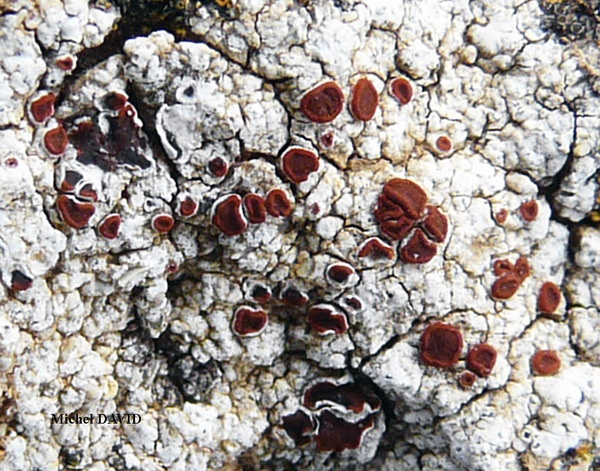
Michel David - Source: http://www.lichensmaritimes.org/index.php?task=fiche&lichen=911&lang=en
Greece, parasitant Aspicilia calcarea Crète Héraklion
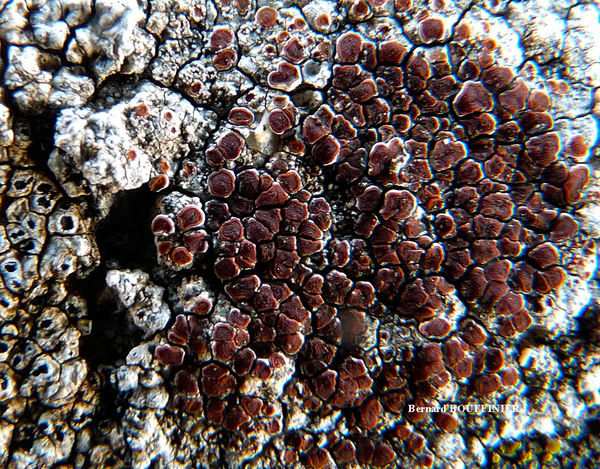
Bernard Bouffinier - Source: http://www.lichensmaritimes.org/index.php?task=fiche&lichen=911&lang=en
Italy, Sardinia
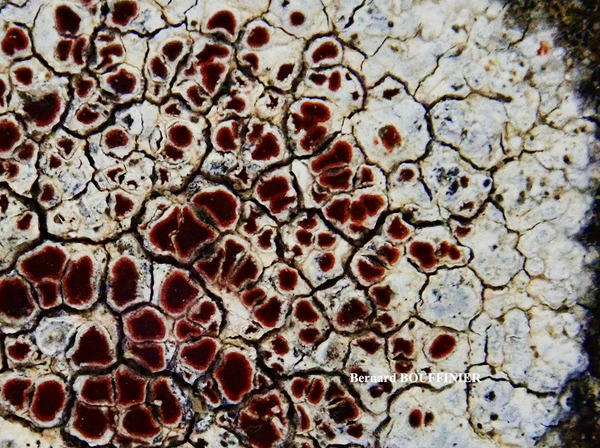
Bernard Bouffinier - Source: http://www.lichensmaritimes.org/index.php?task=fiche&lichen=911&lang=en
France, Povence, Manosque
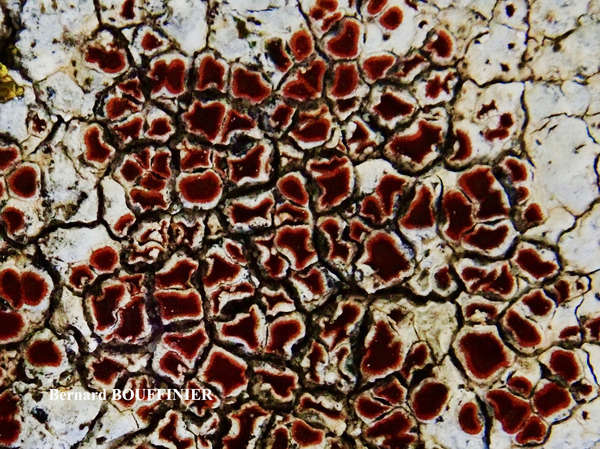
Bernard Bouffinier - Source: http://www.lichensmaritimes.org/index.php?task=fiche&lichen=911&lang=en
France, Povence, Manosque
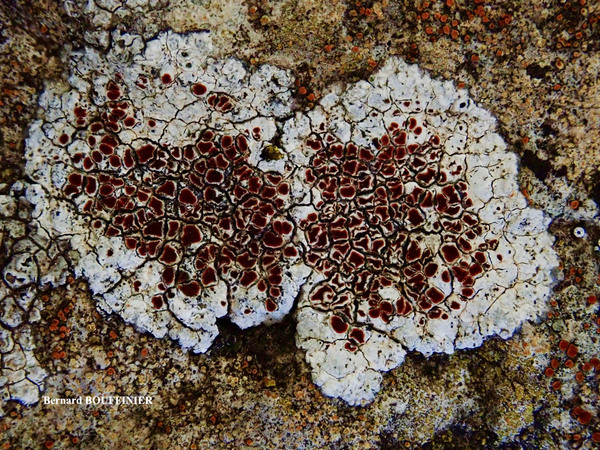
Bernard Bouffinier - Source: http://www.lichensmaritimes.org/index.php?task=fiche&lichen=911&lang=en
France, Povence, Manosque
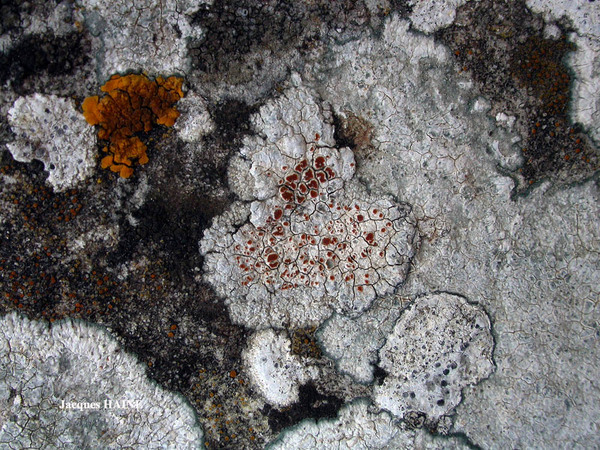
Jaques Haine - Source: http://www.lichensmaritimes.org/index.php?task=fiche&lichen=911&lang=en
France, Drôme provençale
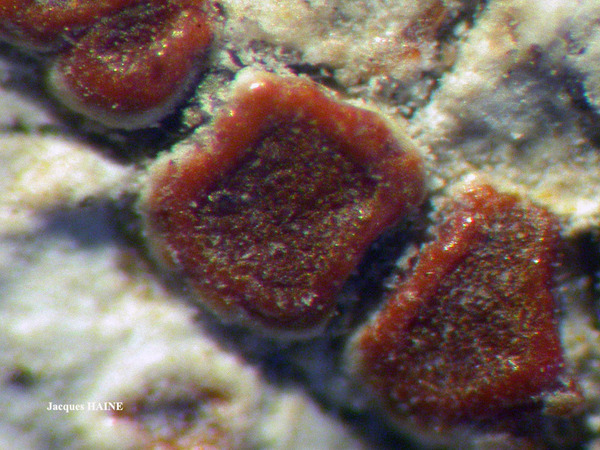
Jaques Haine - Source: http://www.lichensmaritimes.org/index.php?task=fiche&lichen=911&lang=en
France, Drôme provençale
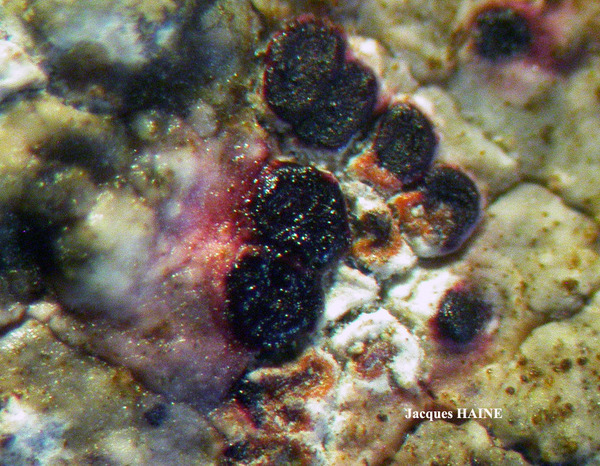
Jaques Haine - Source: http://www.lichensmaritimes.org/index.php?task=fiche&lichen=911&lang=en
France, Drôme provençale
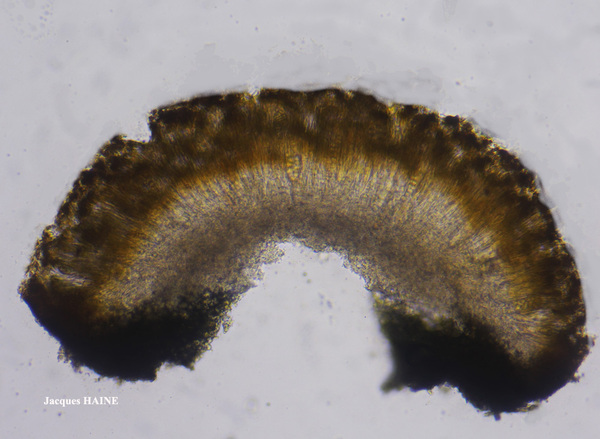
Jaques Haine - Source: http://www.lichensmaritimes.org/index.php?task=fiche&lichen=911&lang=en
France, Drôme provençale
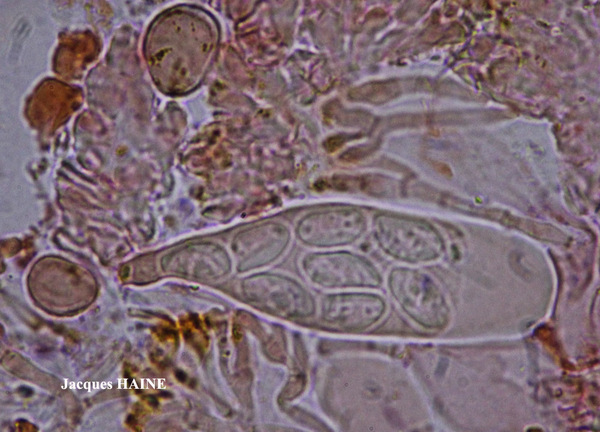
Jaques Haine - Source: http://www.lichensmaritimes.org/index.php?task=fiche&lichen=911&lang=en
France, Drôme provençale
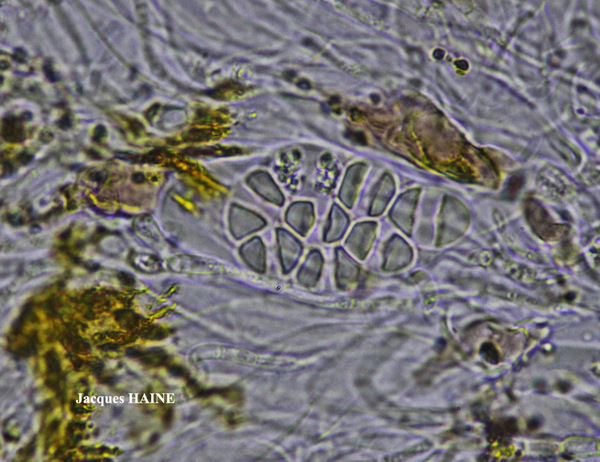
Jaques Haine - Source: http://www.lichensmaritimes.org/index.php?task=fiche&lichen=911&lang=en
France, Drôme provençale
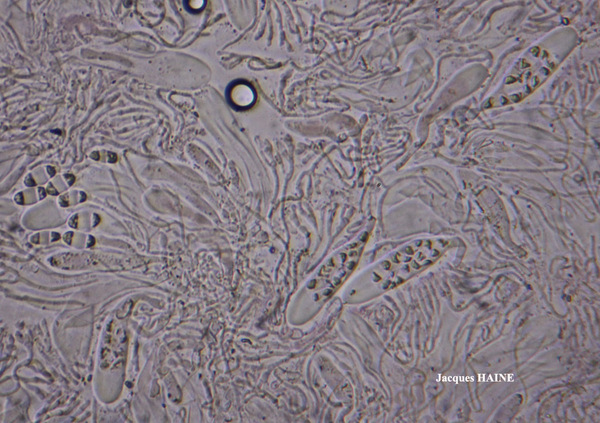
Jaques Haine - Source: http://www.lichensmaritimes.org/index.php?task=fiche&lichen=911&lang=en
France, Drôme provençale
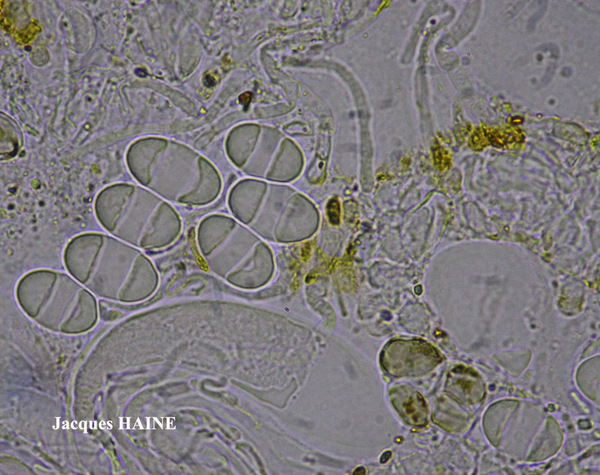
Jaques Haine - Source: http://www.lichensmaritimes.org/index.php?task=fiche&lichen=911&lang=en
France, Drôme provençale
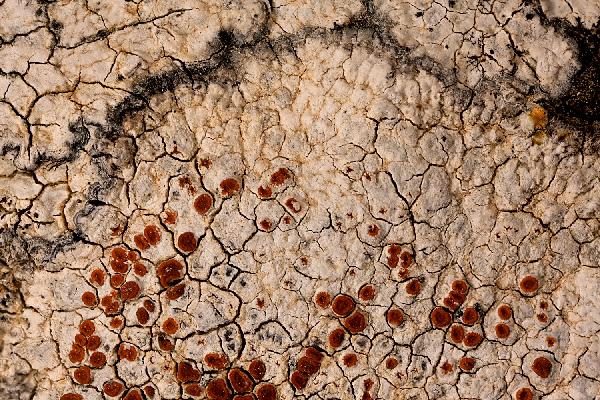
Ulrich Kirschbaum CC BY-SA 4.0 - Source: https://www.thm.de/lse/ulrich-kirschbaum/flechtenbilder
SE-Europe; N-Cyprus; SE of Girne; Beşparmak Mountains; Buffavento Castle (and surroundings); 3.
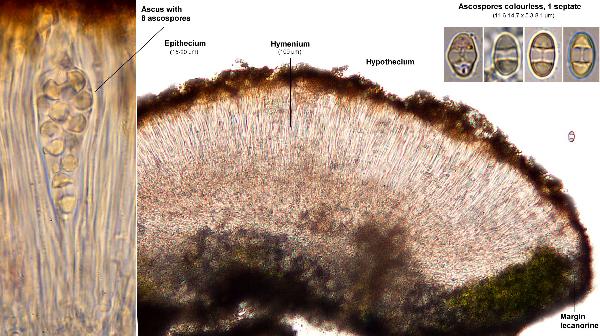
Ulrich Kirschbaum CC BY-SA 4.0 - Source: https://www.thm.de/lse/ulrich-kirschbaum/flechtenbilder
SE-Europe; N-Cyprus; SE of Girne; Beşparmak Mountains; Buffavento Castle (and surroundings); 3.
Growth form: Crustose
Substrata: rocks
Photobiont: green algae other than Trentepohlia
Reproductive strategy: mainly sexual
paras Circinaria calcarea when young
Commonnes-rarity: (info)
Alpine belt: absent
Subalpine belt: absent
Oromediterranean belt: absent
Montane belt: rather rare
Submediterranean belt: very common
Padanian area: rare
Humid submediterranean belt: extremely common
Humid mediterranean belt: common
Dry mediterranean belt: rather common

Predictive model
| Herbarium samples |


P.L. Nimis; Owner: Department of Life Sciences, University of Trieste
Herbarium: TSB (7207)
2001/11/13


A. Moro; Owner: Department of Life Sciences, University of Trieste
Sicilia, TP, Erice, dintorni della città
2008.04.05


A. Moro; Owner: Department of Life Sciences, University of Trieste
Sicilia, TP, Segesta, presso i templi
2008.04.05


A. Moro; Owner: Department of Life Sciences, University of Trieste
Sicilia, TP, Segesta, presso i templi
2008.04.05


Juri Nascimbene – CC BY-SA 4.0; Owner: Department of ùLife Sciences, University of Trieste
Vette Feltrine, Veneto, Italy


Felix Schumm – CC BY-SA 4.0
[12291], Griechenland, N-Samos, bei Manolates südlich von Agios Konstandinos, 37°47.185'N, 26°49.533'E, 341 m; halbschattige bis besonnte Terrassenmauern. Leg Schumm 02.05.2006, det. Schumm 2006.


Felix Schumm – CC BY-SA 4.0
[13404], Griechenland, S-Kreta, Gebirgszug zwischen Pombia und Pigedakia, westl. des Gipfels Vigla, 34°59.880' N, 24°52.150' E, 420 m. Leg. F. Schumm & R. Düll, 16.10.2007, det. A. Aptroot 2016.


Felix Schumm – CC BY-SA 4.0
[13404], Griechenland, S-Kreta, Gebirgszug zwischen Pombia und Pigedakia, westl. des Gipfels Vigla, 34°59.880' N, 24°52.150' E, 420 m. Leg. F. Schumm & R. Düll, 16.10.2007, det. A. Aptroot 2016.


Felix Schumm – CC BY-SA 4.0
[13572], Griechenland, S-Kreta, Asteroussia Berge, Blockhalde nordöstlich von Ethia in Richtung Keraies, 34°59.526' N, 25°12.693' E, 830 m. Leg. F. Schumm & R. Düll, 25.10.2007, det. A. Aptroot 2016.


Felix Schumm – CC BY-SA 4.0
[13572], Griechenland, S-Kreta, Asteroussia Berge, Blockhalde nordöstlich von Ethia in Richtung Keraies, 34°59.526' N, 25°12.693' E, 830 m. Leg. F. Schumm & R. Düll, 25.10.2007, det. A. Aptroot 2016.


Felix Schumm – CC BY-SA 4.0
[13404], Griechenland, S-Kreta, Gebirgszug zwischen Pombia und Pigedakia, westl. des Gipfels Vigla, 34°59.880' N, 24°52.150' E, 420 m. Leg. F. Schumm & R. Düll, 16.10.2007, det. A. Aptroot 2016.

Michel David - Source: http://www.lichensmaritimes.org/index.php?task=fiche&lichen=911&lang=en
Greece, parasitant Aspicilia calcarea Crète Héraklion

Michel David - Source: http://www.lichensmaritimes.org/index.php?task=fiche&lichen=911&lang=en
Greece, parasitant Aspicilia calcarea Crète Héraklion

Michel David - Source: http://www.lichensmaritimes.org/index.php?task=fiche&lichen=911&lang=en
Greece, parasitant Aspicilia calcarea Crète Héraklion

Bernard Bouffinier - Source: http://www.lichensmaritimes.org/index.php?task=fiche&lichen=911&lang=en
Italy, Sardinia

Bernard Bouffinier - Source: http://www.lichensmaritimes.org/index.php?task=fiche&lichen=911&lang=en
France, Povence, Manosque

Bernard Bouffinier - Source: http://www.lichensmaritimes.org/index.php?task=fiche&lichen=911&lang=en
France, Povence, Manosque

Bernard Bouffinier - Source: http://www.lichensmaritimes.org/index.php?task=fiche&lichen=911&lang=en
France, Povence, Manosque

Jaques Haine - Source: http://www.lichensmaritimes.org/index.php?task=fiche&lichen=911&lang=en
France, Drôme provençale

Jaques Haine - Source: http://www.lichensmaritimes.org/index.php?task=fiche&lichen=911&lang=en
France, Drôme provençale

Jaques Haine - Source: http://www.lichensmaritimes.org/index.php?task=fiche&lichen=911&lang=en
France, Drôme provençale

Jaques Haine - Source: http://www.lichensmaritimes.org/index.php?task=fiche&lichen=911&lang=en
France, Drôme provençale

Jaques Haine - Source: http://www.lichensmaritimes.org/index.php?task=fiche&lichen=911&lang=en
France, Drôme provençale

Jaques Haine - Source: http://www.lichensmaritimes.org/index.php?task=fiche&lichen=911&lang=en
France, Drôme provençale

Jaques Haine - Source: http://www.lichensmaritimes.org/index.php?task=fiche&lichen=911&lang=en
France, Drôme provençale

Jaques Haine - Source: http://www.lichensmaritimes.org/index.php?task=fiche&lichen=911&lang=en
France, Drôme provençale

Ulrich Kirschbaum CC BY-SA 4.0 - Source: https://www.thm.de/lse/ulrich-kirschbaum/flechtenbilder
SE-Europe; N-Cyprus; SE of Girne; Beşparmak Mountains; Buffavento Castle (and surroundings); 3.

 INDEX FUNGORUM
INDEX FUNGORUM
 GBIF
GBIF
 DOLICHENS
DOLICHENS

